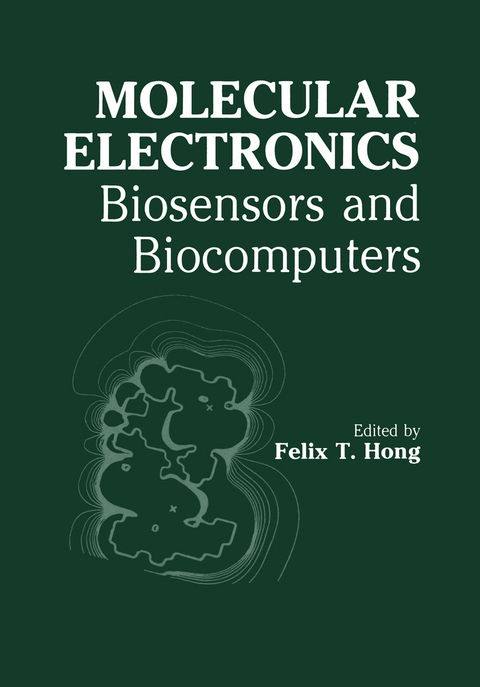
Molecular Electronics
Springer-Verlag New York Inc.
978-1-4615-7484-2 (ISBN)
A Pioneer in Molecular Electronics.- A Pioneer in Molecular Electronics.- Fabrication of Molecular Assemblies.- Forrest L. Carter Lecture: Organized Monolayers — Building Blocks in Constructing Supramolecular Devices.- Syntheses of Electrically Conductive LB Films and Host-Guest LB Films of Cyclodextrins and Azobenzenes.- Artificial Structure of Metal Complexes by Selective Coordination Epitaxy.- Industrial Scale Production of L-B Layers.- Characterization of Molecular Assemblies.- Depth Profiling in Organic Thin Films with Optical Guided Waves.- Synchrotron X-Ray Studies on Lipid Monolayers.- Fluorescence Image Analysis of the Spatial Organization of Lipid Layers.- Electrochemical Aspect of Molecular Electronics.- Electrochemical Processes in Membrane Channels and Biosynthetic Structures.- Electroconformational Coupling: A fundamental Process of Biomolecular Electronics for Signal Transductions.- The Role of Solvent Permittivity Dispersion in Electrostatic Interactions in Proteins.- An Electrochemical Approach to the Design of Membrane-Based Molecular Optoelectronic Devices.- Metallo-Proteins and other Electroactive Molecules.- Biomolecular Electronics: Structure ? Function Relationship.- Synthetic Models for Photoinduced Electron Transfer Reactions.- Electron Transfer Rates in Mitochondrial Proteins: Regulation and Specificity.- Dye Binding to Polytryptophan and Lysine-Tryptophan copolymer: Electron Transfer Quenching by Biopol3rmer Pendant Groups.- Photoactive Interfacially Polymerized Polyporphyrin Films.- Retinal Proteins and other Pigment Proteins.- Light Energy Transducing and Signal Transducing Rhodopsins of Halobacteria.- Visual Phototransduction: Biochemical Aspects.- Biological Photosensors: Phytochrome and Stentorin.- Animal Rhodopsin as a PhotoelectricGenerator.- A Correlation between Photocycle and Photoelectric Response of Bacteriorhodopsin Monomers.- Biological Information Processing.- Neurons as Microprocessors with a Kind of Memory Function.- Phase Wave and Perception of Amoeboid Cells.- Microtubules: Possible Application to Computer Technologies.- Information Processing in Microtubules: Biomolecular Automata and Nanocomputers.- Molecular Device and Biosensor Technology.- BLM-Based Biosensors and Devices: Applications and Future Prospects.- Biomolecular Interface.- On the Volt-Ampere Characteristics of Molecular Monoelectronic Elements.- Immobilization of Nicotinamide Adenine Dinucleotide: Implications in Molecular Electronics and Bioengineering.- ISFET-Like Devices Coupled to Neuroblastoma Cells: Cytometric and Electrical Characterization.- Incorporation of Ion Channels in Polymerized Membranes and Fabrication of a Biosensor.- Molecular Sensors Based on Olfactory Transduction.- Monolayer Molecular Recognition Sites as a Basis for Biosensor Development.- Au/Langmuir-Blodgett Film/Zn Se Tunnel Injection Light-Emitting Structures.- Design of a True Molecular Electronic Device: the Electron Transfer Shift Register Memory.- Ultra High Speed Bacteriorhodopsin Photodetectors.- Optical Random Access Memory Based on Bacteriorhodopsin.- Actual Possibilities of Bacteriorhodopsin Application in Optoelectronics.- General and Theoretical Aspects of Molecular Jilectronics.- Towards the Molecular Computer Factory.- Ultralow Frequency “Optical” Biocomputers: Biophysical Arguments.- Mathematical Problems Arising in Molecular Electronics: Global Geometry and Dynamics of the Double-Well Potential.- Nanoelectronics and Scanning Tunneling Engineering.- Contributors.
| Zusatzinfo | 8 Illustrations, color; 189 Illustrations, black and white; 466 p. 197 illus., 8 illus. in color. |
|---|---|
| Verlagsort | New York, NY |
| Sprache | englisch |
| Maße | 178 x 254 mm |
| Themenwelt | Naturwissenschaften ► Biologie ► Biochemie |
| Naturwissenschaften ► Biologie ► Zoologie | |
| Naturwissenschaften ► Chemie ► Physikalische Chemie | |
| Naturwissenschaften ► Physik / Astronomie ► Angewandte Physik | |
| Technik ► Umwelttechnik / Biotechnologie | |
| ISBN-10 | 1-4615-7484-6 / 1461574846 |
| ISBN-13 | 978-1-4615-7484-2 / 9781461574842 |
| Zustand | Neuware |
| Haben Sie eine Frage zum Produkt? |
aus dem Bereich


